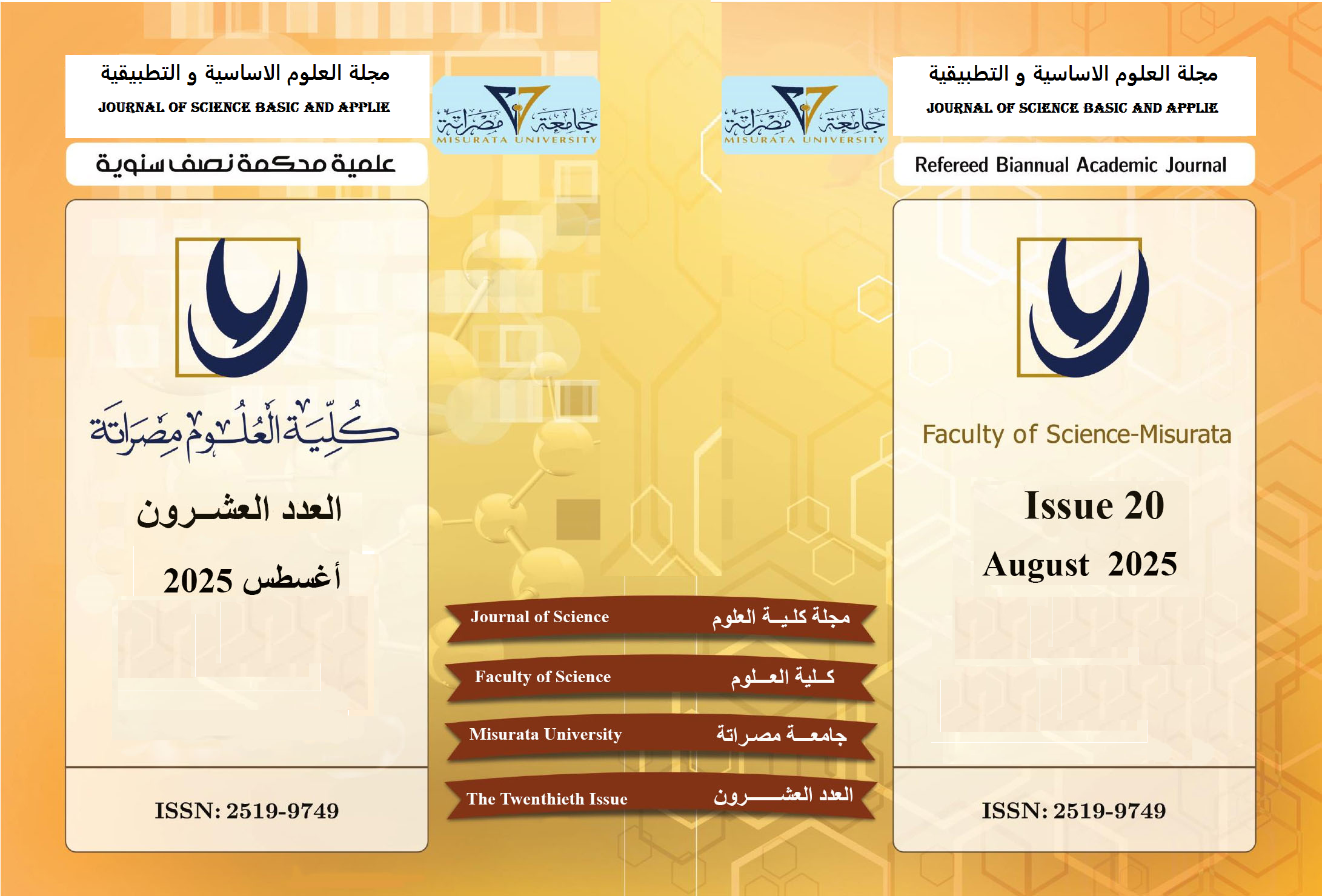عالقة ارتفاع سكر الدم ببعض معايير الدم البيو كيميائية للحاالت المترددة على المركز المتخصص بالسكرى والغدد الصماء مصراتة.
الكلمات المفتاحية:
ارتفاع سكر الدم، معايير الدم البيو كيميائية، المركز المتخصص بالسكرى والغدد الصماء مصراتةالملخص
مرض السكري احد الأمراض واسعة الانتشار عالمياً، ويعاني المرضى العديد من الاعتلالات والمضاعفات، الأمر الذي يؤدي إلى تفاقم حالتهم الصحية، وهو اضطراب في الغدة الصماء نتيجة اختلال في عملية أيض السكر و يؤدى لارتفاع مستوى السكر (الجلوكوز) في الدم بصورة غير طبيعية لأسباب مختلفة قد تكون نفسية أو عضوية أو بسبب الإفراط في تناول السكريات أو العوامل الوراثية، تناولت هذه الدراسة علاقة ارتفاع سكر الدم ببعض معايير الدم البيو كيميائية للحالات المترددة على المركز المتخصص بالسكرى والغدد الصماء مصراتة ، وشملت الدراسة 100 مريض تم اختيارهم بصورة عشوائية فى الفترة الصباحية خلال الفترة الزمنية من 1يوليو 2017 الى 31 يوليو 2018، و تراوحت نسبة الرجال 47% بينما نسبة النساء 53%، واعمار المرضى بين (92-32) سنة، ومن النتائج المتحصل عليها ان اغلب المرضى كانوا من الفئة العمرية (51-70) سنة، وهم مستخدمين العلاج بالأنسولين والاقراص في نفس الوقت، وتاريخهم المرضى اكثر من 10 سنوات، وعند دراسة العلاقة بين المتغيرات وجدت علاقة طردية قوية بين العمر وتاريخ المرض وارتفاع سكر الدم والدهون الثلاثية، وان ارتفاع نسبة الكرياتنيين مرتبطة بارتفاع البولينا في الدم ، وفى حين هنالك علاقة بين ارتفاع نسبة الكولسترول والدهون الثلاثية لمعظم المرضى عند قيمة معنوية اقل من 0.05 .
المراجع
1.Definition, W., diagnosis and classification of diabetes mellitus and its complications. Part 1: diagnosis and classification of diabetes mellitus. World Health Organization, Department of Noncommunicable Disease Surveillance.Geneva, 1999.
2. Atkinson, M.A. and G.S. Eisenbarth, Type1 diabetes: new perspectives on disease pathogenesis and treatment. The lancet, 2001. 358(9277): p. 221-229.
3.Alsaimary, I.E.A., Bacterial wound infections in diabetic patients and their therapeutic implications. Medical Practice and Reviews, 2010. 1(2): p. 12-15.
4.Rosenbloom, A.L., Emerging epidemic of type 2 diabetes in youth. Diabetes care, 1999. 22(2): p. 345-354.
5.Association, A.D., Type 2 diabetes in children and adolescents. American Diabetes Association. Diabetes care, 2000. 23(3): p. 381-389.
6.Pediatrics, A.D.A.J., Type 2 diabetes in children and adolescents. 2000. 105(3): p. 671-680.
7.Al Mansour, M.A.J.I.j.o.e.r. and p. health, The prevalence and risk factors of type 2 diabetes mellitus (DMT2) in asemi-urban Saudi population. 2020. 17(1): p. 7.
8.Thelin, A. and S.J.I.J.D.C.R. Holmberg, Type 2 Diabetes and Lifestyle—A Prospective Population-Based Cohort Study among Rural Men. 2014. 1: p. 2-5.
9.Zimmet, P., K. Alberti, and J.J.N. Shaw, Global and societal implications of the diabetes epidemic. 2001. 414(6865): p. 782-787.
10.Warjukar, P.,., Study of microalbuminuria and uric acid in type 2 diabetes mellitus. 2020. 2020.
11.Matheus, A.S.d.M., , Impact of diabetes on cardiovascular disease: an update. 2013.2013.
12.Vesa, C.M.,., Exploration of insulin sensitivity, insulin resistance, early insulin secretion and β-cell function, and their relationship with glycated hemoglobin level in normal weight patients with newly diagnosed type 2 diabetes mellitus. 2019. 70: p. 4217-4223.
13.Azab, A.E., A.M. Mansour, and M.O. Albasha, The Relationship between Diabetes, Hypertension, Heart, and Kidney Diseases.
14.Azab, A.E., M.O. Albasha, and A.M. Mansour, Renal Diseases Risk Factors Among Diabetic Patients with and without Hypertension in Messelata Region Libya.
15.Sesso, R.C., , Report of the Brazilian chronic dialysis census 2012. 2014. 36: p. 48-53.
16.Kushwaha, J., , A study on type2 diabetes mellitus patients in relation to lipid profile attending tertiary care hospital in Kanpur.





